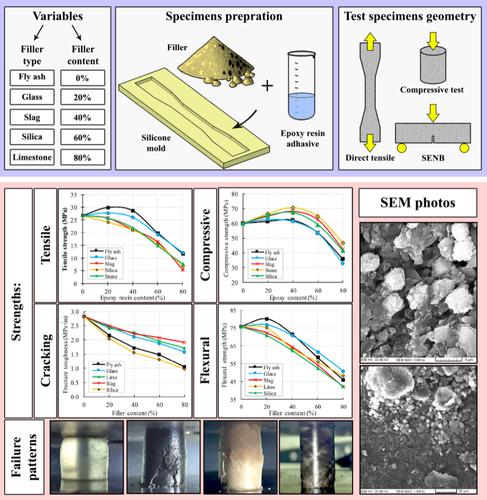当前位置:
X-MOL 学术
›
Polym. Compos.
›
论文详情
Our official English website, www.x-mol.net, welcomes your feedback! (Note: you will need to create a separate account there.)
Mechanical, fracture, and environmental performance of greener polymer composites containing low to high micro fillers with recycled and byproduct origins
Polymer Composites ( IF 5.2 ) Pub Date : 2024-03-26 , DOI: 10.1002/pc.28369 Ehsan Khedri 1 , Hamid Reza Karimi 2 , Razie Mohamadi 1, 3 , M.R.M. Aliha 4, 5 , Reza Masoudi Nejad 6
The incorporation of recycled or byproduct fillers in epoxy resin composites. Examined fillers include fly ash, glass, slag, silica, and limestone powder. Tensile, compressive, flexural, and fracture tests were conducted. SEM and failure patterns were analyzed, and similar studies were compared. Cost‐strength and CO2eq‐strength data evaluated.
中文翻译:

含有回收和副产品来源的低至高微填料的绿色聚合物复合材料的机械、断裂和环境性能
聚合物粘合剂具有相当大的机械和环境优势;然而,它们的高价格使得它们无法用于普通用途。本研究研究了在环氧树脂基复合材料中加入回收或副产品填料,以评估其机械性能、环境影响和成本效率。所检查的填料包括粉煤灰、玻璃粉、矿渣、硅石粉和石灰石粉。对具有不同填料比例(0%–80%重量)的复合材料进行拉伸、压缩和断裂测试。从微观结构观察,可以看到圆形(粉煤灰、玻璃粉)和粗糙(矿渣、二氧化硅和石灰石粉)形态。此外,可以看出所有填料都很好地分布在基体中;随着填料含量的增加,气孔增加。拉伸和压缩结果表明,添加填料可提高复合材料的强度,与纯环氧树脂相比,强度提高高达 20%。然而,当填料含量超过40%时,强度下降。断裂韧性值也会随着填料含量的增加而降低。将结果与其他研究的结果进行比较表明趋势的相似性。对成本强度和二氧化碳当量强度曲线进行了评估,以评估财务和环境方面的情况。该复合材料显示出成本效率的潜力,但与水泥混凝土等传统建筑材料相比,可能存在一些环境缺陷。 在环氧树脂复合材料中加入回收或副产品填料。 检查的填料包括飞灰、玻璃、矿渣、二氧化硅和石灰石粉。 进行了拉伸、压缩、弯曲和断裂测试。 分析了 SEM 和失效模式,并比较了类似的研究。 评估成本强度和 CO2eq 强度数据。
更新日期:2024-03-26
Polymer Composites ( IF 5.2 ) Pub Date : 2024-03-26 , DOI: 10.1002/pc.28369 Ehsan Khedri 1 , Hamid Reza Karimi 2 , Razie Mohamadi 1, 3 , M.R.M. Aliha 4, 5 , Reza Masoudi Nejad 6
Affiliation

|
中文翻译:

含有回收和副产品来源的低至高微填料的绿色聚合物复合材料的机械、断裂和环境性能



























 京公网安备 11010802027423号
京公网安备 11010802027423号